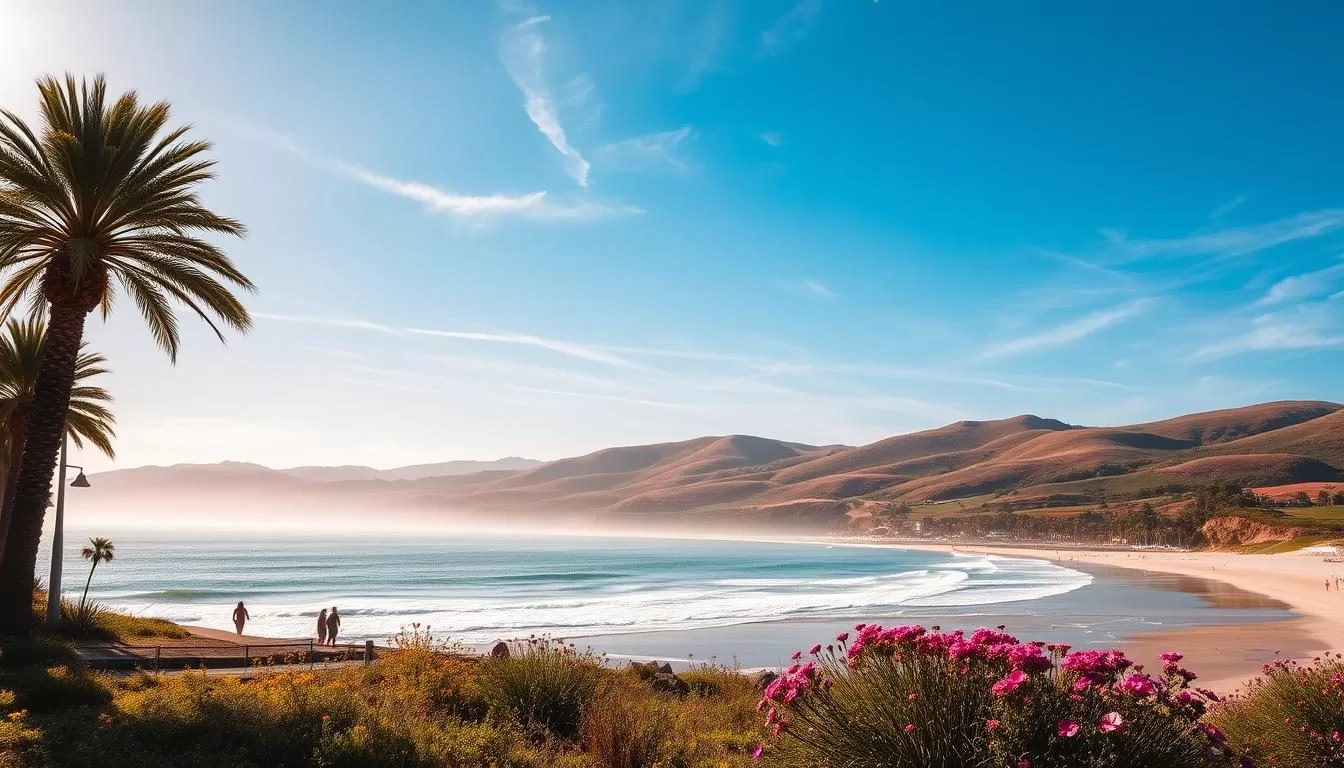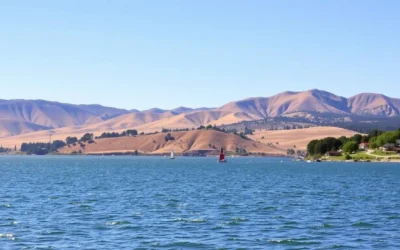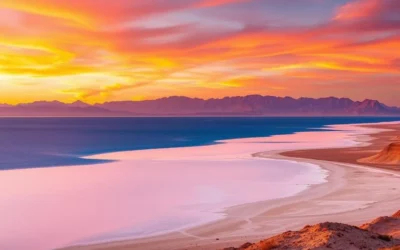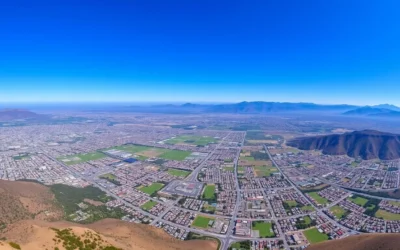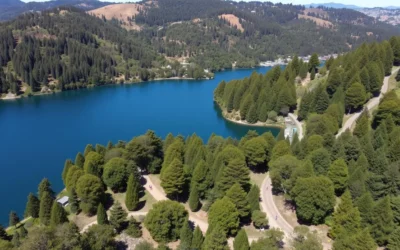✓ Accommodations ✓ Flights ✓ Rental Cars ✓ Tours & Activities
Planning a trip to California can be a daunting task, given the state’s diverse climate patterns. To make the most of your visit, understanding the weather conditions is crucial.
The climate in California varies significantly between coastal and inland areas, with the marine layer, a coastal fog, impacting weather conditions, especially during the summer.
The seasons that offer the most pleasant experience are spring (March-May) and fall (September-November). During these periods, you can enjoy a wide range of activities, from sunny beach days to outdoor adventures, making your trip truly unforgettable.
Understanding California’s Diverse Climate
Understanding California’s climate is crucial for planning a trip, given its diverse weather patterns across the state. California’s climate varies significantly due to its large geographical expanse.
Mediterranean Climate Patterns
California is predominantly known for its Mediterranean climate, characterized by warm, dry summers and mild, wet winters. This climate type is prevalent in areas like Los Angeles, where temperatures remain mild year-round. The Mediterranean climate pattern means that the summers are usually dry and warm, while winters are mild with occasional rain.
Coastal vs. Inland Temperature Variations
A notable aspect of California’s climate is the temperature difference between the coastal and inland areas. The coast tends to be cooler due to the ocean’s influence, while inland areas are generally warmer and drier. This temperature variation can be as much as 20°F on the same day, especially during the summer months.
| Region | Summer Temperature | Winter Temperature |
|---|---|---|
| Coastal | Mild (75°F) | Mild (50°F) |
| Inland | Hot (90°F) | Mild (45°F) |
Spring in California: March to May
As winter fades, California bursts into spring, offering mild temperatures and breathtaking natural beauty from March to May. This season is a perfect time to enjoy the state’s diverse landscapes and attractions.
Temperature and Precipitation Overview
During spring, California’s temperatures gradually warm up. March starts with temperatures ranging from 60-70°F in Southern California and 50-60°F in Northern California, with occasional rainfall. By April, precipitation decreases, and temperatures rise, making it ideal for outdoor activities. May brings near-perfect weather conditions, with temperatures in the 70s along the coast and 80s inland.
| Month | Southern California Temp | Northern California Temp | Precipitation |
|---|---|---|---|
| March | 60-70°F | 50-60°F | Occasional Rainfall |
| April | 65-75°F | 55-65°F | Decreasing |
| May | 70-80°F | 60-70°F | Minimal |
Spring Blooms and Natural Beauty
Spring is the prime season to witness California’s famous wildflower blooms, including the spectacular orange poppy fields at Antelope Valley California Poppy Reserve. The Huntington Gardens are also a must-visit, with over 1,200 types of camellia flowers blooming during this time. You can experience the beauty of spring by visiting these and other natural attractions.
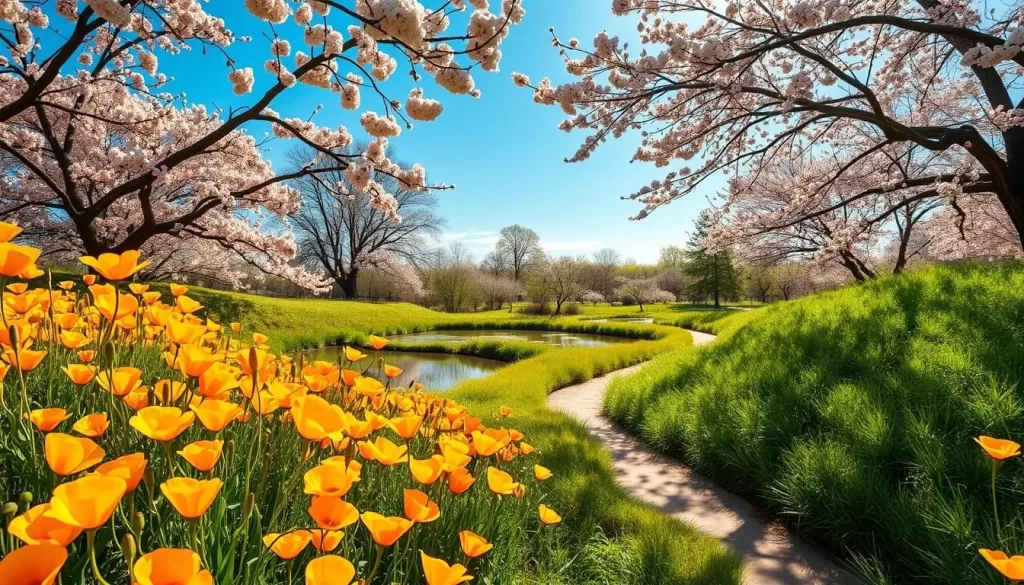
Outdoor Activities and Events
Spring in California is great for outdoor activities and events. You can enjoy hiking in national and state parks as snow melts, revealing lush green landscapes and flowing waterfalls. Popular spring events include the Coachella Valley Music and Arts Festival and the California Strawberry Festival. It’s also a perfect time to explore desert regions like Joshua Tree National Park before the summer heat begins.
Summer in California: June to August
California comes alive during the summer months, offering a diverse range of experiences that cater to all interests and preferences. The warm weather and long days create an ideal setting for outdoor activities and events.
Managing the “June Gloom”
June is often characterized by “June Gloom,” a coastal fog that can persist until midday. This phenomenon keeps temperatures cooler and cloudy until the afternoon, making it essential for visitors to pack layers for their morning excursions. As the day progresses, the fog typically clears, revealing sunny skies.
Beach vs. City Temperature Differences
One of the unique aspects of summer in California is the noticeable temperature difference between coastal areas and inland cities. While beaches remain cool, with temperatures ranging from 65-75°F, inland areas can experience much higher temperatures, often reaching 90-100°F. This variation allows visitors to choose their preferred climate.
Summer Festivals and Events
Summer is peak tourist season in California, with a packed calendar of events and festivals. From music festivals to outdoor concerts and cultural celebrations, there’s something for everyone. Popular attractions like Disneyland and Yosemite National Park are particularly busy during this time, drawing large crowds. However, the excitement and variety of summer events make it a great time to experience all that California has to offer.
Fall in California: September to November
The fall season in California offers a unique blend of warm days and cool nights, making it an ideal time to visit. As summer fades, autumn in LA brings mild weather, perfect for visiting the City of Angels. Temperatures range from 63°F to 74°F, offering a cool break from summer’s heat.
Perfect Weather Windows
Fall in California, from September to November, provides some of the year’s most pleasant weather, with warm days, cool nights, and minimal rainfall. September remains warm throughout the state, while October brings slightly cooler temperatures. You can enjoy fewer crowds after the summer tourist season, making it a great time to explore.
Fall Colors and Scenery
The fall season brings vibrant colors to California’s mountain regions and wine country. In October, the Sierra Nevada mountains and gold country peak with spectacular scenery, ideal for photographers and nature lovers. You can enjoy the beautiful landscapes and take in the natural beauty of the state.
Harvest Season Activities
Wine country comes alive during harvest season, with numerous festivals and events celebrating the grape harvest throughout Napa, Sonoma, and other wine regions. You can participate in various activities such as harvest festivals, pumpkin patches, and farm tours, providing unique seasonal experiences. The comfortable temperatures make it an ideal time for outdoor activities like hiking and biking.
Winter in California: December to February
Winter in California, which typically lasts from December to February, brings a refreshing change to the state’s usual sunny weather. You can experience a diverse range of climates and activities during this season, from the mild coastal regions to the snow-covered mountains.
Rainfall Patterns and Clear Skies
California’s winter is characterized by varied rainfall patterns. Coastal regions receive most of their annual rainfall during these months, with Northern and Central California experiencing the most significant precipitation. However, between rain showers, clear skies are common, offering spectacular views and photo opportunities. For instance, Los Angeles gets 2.35 inches of rain in December, but the skies clear up afterward, making it perfect for sightseeing with comfortable temperatures around 68°F during the day.
Winter Activities and Events
Winter transforms California into a playground for various activities and events. The Sierra Nevada mountains become a paradise for skiing and snowboarding enthusiasts, with resorts like Mammoth Mountain and Lake Tahoe offering world-class facilities. Meanwhile, the desert regions enjoy their most pleasant temperatures during winter, making it an ideal time to explore places like Death Valley and Joshua Tree. You can also witness unique natural phenomena, such as monarch butterfly migrations and gray whale watching.
What to Pack for Winter Travel
When traveling to California during winter, it’s essential to pack layers due to the significant variation in temperatures between day and night, as well as across different regions. Although rain is a possibility, especially in Northern and Central California, the overall weather remains mild compared to other parts of the country. This makes winter an excellent time to visit, with fewer crowds and a range of exciting events and activities to enjoy.
California, United States: Best Months for a Weather-Savvy Trip
To ensure a pleasant journey, it’s essential to know the optimal months for visiting California. The state’s diverse climate means that the best time to visit can vary significantly depending on your planned activities and destinations.
Spring and Fall: The Sweet Spots
For most travelers, the spring (March to May) and fall (September to November) seasons represent the ideal times to visit California. During these periods, the weather is generally mild, with temperatures in the 60s Fahrenheit, making them perfect for outdoor activities. These shoulder seasons offer fewer crowds and a wide range of events, enhancing your overall travel experience.
- The best months for a weather-savvy trip are April-May and September-October.
- These periods provide mild temperatures and minimal rainfall.
- You can enjoy major attractions without the peak season crowds.
Weather Considerations for Different Activities
When planning your trip or adventure in California, consider the specific weather conditions for your activities. For instance, beach activities are best enjoyed from late summer through early fall, while desert explorations are more pleasant in spring or fall.
- For beach activities, visit between August and October for warm ocean temperatures.
- Desert explorations are best in spring (March-April) for wildflowers or fall (October-November) for comfortable temperatures.
- Wine country visits are rewarding during harvest season (September-October).
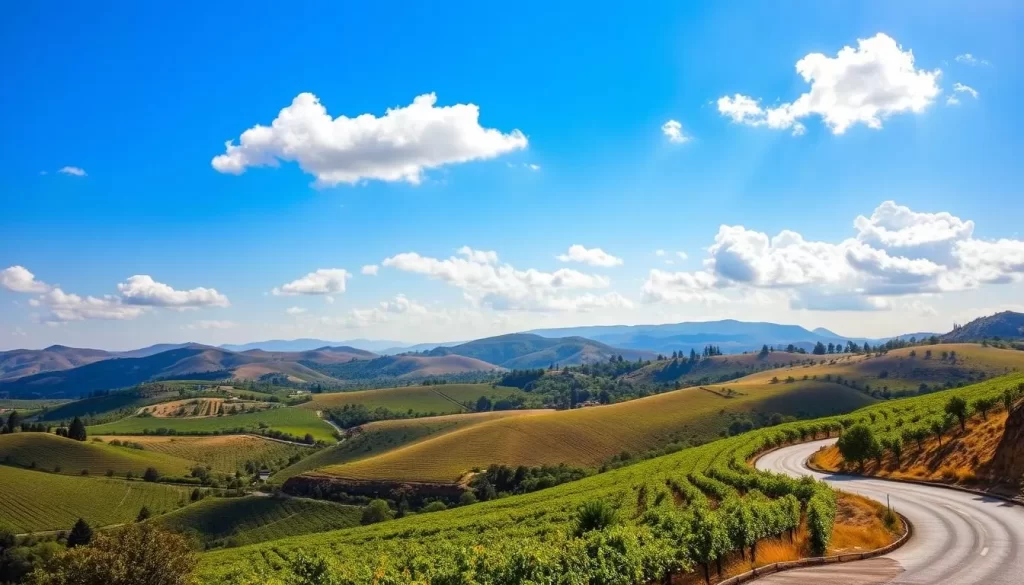
Regional Weather Guide: Northern California
Northern California’s weather is as diverse as its landscapes, ranging from foggy coastal areas to sunny inland valleys. This diversity is due to the region’s varied geography, which includes coastal areas, mountains, and valleys.
San Francisco Bay Area Climate
The San Francisco Bay Area experiences a unique microclimate, characterized by mild temperatures year-round and a short rainy season from November to April. San Francisco itself is known for its cool and foggy summers, with temperatures rarely exceeding 75°F or dropping below 45°F. The best time to visit San Francisco for clear, sunny weather is during the “Indian summer” months of September and October.
Wine Country Weather Patterns
Wine Country, which includes Napa and Sonoma Valleys, experiences warmer temperatures than San Francisco, with summer highs in the 80s-90s and winter lows in the 30s-40s. The region’s significant day-to-night temperature swings create ideal climate conditions for wine grape cultivation. Understanding these patterns is crucial for planning a visit during the right time of the year.
The climate in Wine Country is generally more extreme than in San Francisco, with hot summers and cool winters. This variation in temperatures contributes to the region’s renowned wine production.
Regional Weather Guide: Central California
Central California encompasses a broad range of climate zones, each with its unique weather characteristics. This diversity makes it essential to understand the regional weather patterns to plan your trip effectively.
Central Coast Climate
The Central Coast, including areas like Monterey, Carmel, and Big Sur, experiences a cool, foggy climate during the summer months. Temperatures along the immediate coast rarely exceed 70°F. The morning fog typically burns off by midday, especially during late summer and early fall, making September and October ideal times to visit for clearer coastal views.
You can enjoy pleasant weather during the shoulder seasons of spring (April-May) and fall (September-October) when the climate is mild and fog is less prevalent.
Central Valley Weather Patterns
The Central Valley, which includes cities like Fresno and Bakersfield, has a different climate profile. It experiences hot, dry summers with temperatures regularly exceeding 95°F from June through September. In contrast, winters bring mild daytime temperatures, ranging from 50-60°F, with fog often settling in the valley from December through February.
| Region | Summer Temperatures | Winter Temperatures | Best Time to Visit |
|---|---|---|---|
| Central Coast | Cool, Foggy (Below 70°F) | Mild | Spring (April-May), Fall (September-October) |
| Central Valley | Hot (Above 95°F) | Mild (50-60°F) | Spring, Fall |
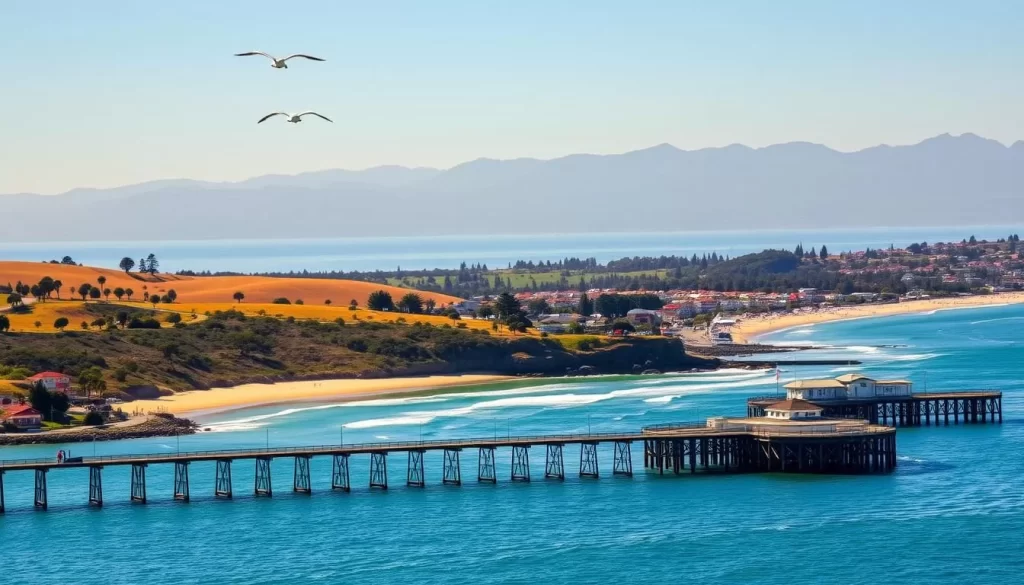
Regional Weather Guide: Southern California
Southern California’s climate is characterized by its pleasant temperatures and abundant sunshine throughout the year. This region includes diverse geographical areas, from coastal cities like Los Angeles and San Diego to desert regions such as Palm Springs and Joshua Tree.
Los Angeles and San Diego Climate
Los Angeles and San Diego experience a Mediterranean climate, with mild temperatures year-round. Average temperatures in these coastal cities range from 65-70°F in winter to 75-85°F in summer. The marine layer, a coastal fog, can impact weather conditions, especially during the summer months, bringing a phenomenon known as “June Gloom” in May and June.
The moderating effect of the Pacific Ocean keeps coastal areas cooler, while inland areas can be significantly warmer. Understanding these temperature variations is key to planning your trip.
Desert Regions Weather Patterns
Desert regions in Southern California, including Palm Springs and Joshua Tree, experience extreme heat during the summer, with temperatures often exceeding 110°F. In contrast, winters are pleasant, with temperatures ranging from 65-75°F. The best time to visit these desert areas is from November through April, when daytime temperatures are comfortable for outdoor activities.
It’s essential to consider the season and weather patterns when planning your visit to these regions to make the most of your trip.
| Region | Summer Temperatures | Winter Temperatures | Best Time to Visit |
|---|---|---|---|
| Los Angeles and San Diego | 75-85°F | 65-70°F | Year-round |
| Desert Regions | Often exceeding 110°F | 65-75°F | November to April |
Monthly Temperature and Rainfall Guide
To make the most of your California trip, it’s essential to grasp the state’s varied weather patterns throughout the year. California’s climate varies significantly across different regions and time.
Average Monthly Temperatures
California’s temperatures vary significantly by region and season. January and February are typically the coolest months, with average temperatures ranging from 45-65°F. July and August are generally the warmest months, with coastal temperatures averaging 65-75°F and inland areas reaching 90-100°F or higher.
Precipitation Patterns
Rainfall patterns in California follow a Mediterranean climate model, resulting in varied conditions across the state. Most rainfall occurs between November and April, with very little during summer months. Northern California receives significantly more rainfall than Southern California.
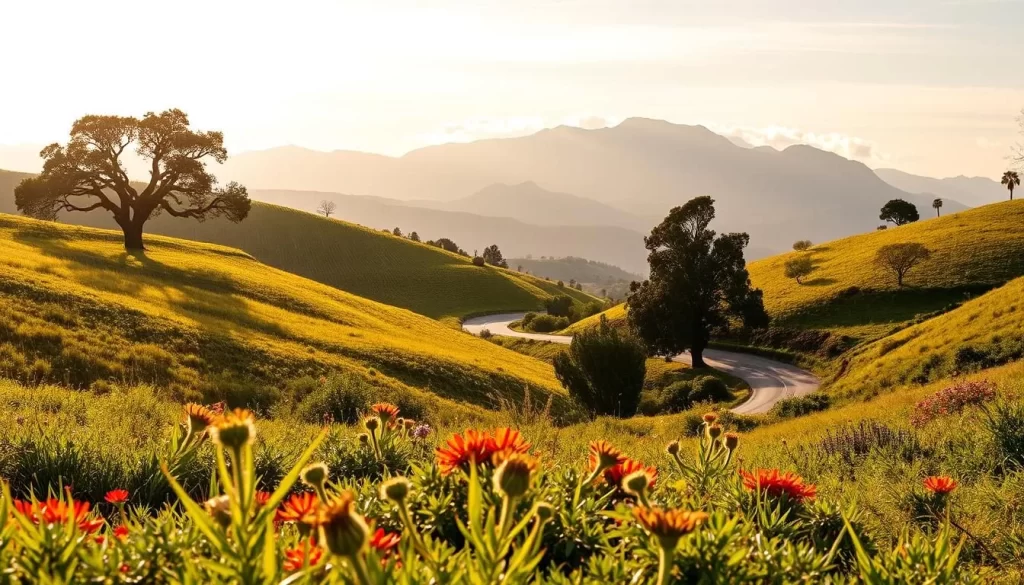
Daylight Hours Throughout the Year
The number of daylight hours varies throughout the year. December has the least daylight, at around 10 hours, while July has the most, at approximately 14.5 hours. Understanding these patterns helps you plan your travel and make the most of your time in California.
Planning Around Major Events and Peak Tourist Seasons
Planning your trip around California’s major events and peak tourist seasons can make a significant difference in your travel experience. Understanding the state’s event calendar and how it impacts crowds and accommodation availability is crucial for a smooth journey.
High Season vs. Off-Season Benefits
California’s peak season, typically during summer (June-August), attracts large crowds and higher prices. However, off-season travel (usually November-March, excluding holidays) offers several benefits, including lower prices, fewer crowds, and a more relaxed atmosphere at major attractions. If you’re looking to avoid the hustle and bustle, consider visiting during the shoulder season (April-May and September-October).
Event Calendar Considerations
Major events like the Coachella Music Festival, San Diego Comic-Con, and the Monterey Jazz Festival draw thousands of visitors, causing accommodation prices to spike. It’s essential to research local events calendars when planning your trip to either participate in or avoid these events depending on your travel preferences. Booking accommodations 3-6 months in advance is recommended for peak season travel.
Weather Impact on Popular Tourist Attractions
To make the most of your trip to California, it’s essential to consider how the weather affects its tourist attractions. The state’s diverse climate and weather conditions can significantly impact the visitor experience.
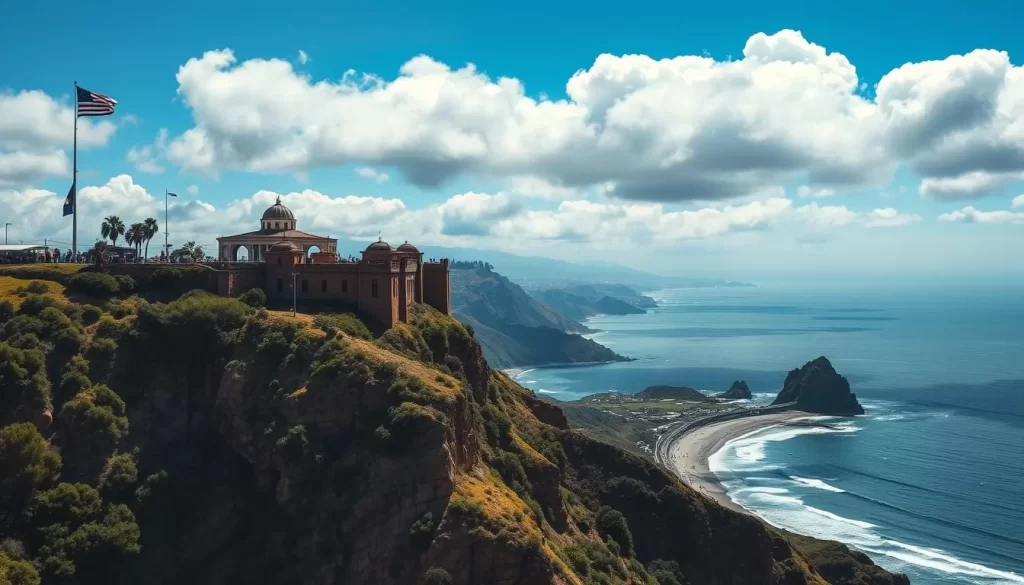
Coastal Attractions Weather Tips
Coastal attractions like the Santa Monica Pier and Big Sur are best enjoyed during late summer and early fall when fog is minimal and temperatures are pleasant. Be mindful of the morning marine layer fog that can obscure views at scenic coastal lookouts.
National Parks Weather Planning
National parks require careful weather planning. For instance, Yosemite’s waterfalls are most impressive in spring, while some high-country trails are inaccessible until summer. Death Valley is best visited in winter or early spring to avoid the extreme heat.
Conclusion: Your Perfect California Weather Window
To make the most of your California adventure, it’s essential to choose the right time to visit. The state’s diverse climate means that the best time for a trip depends on your preferences and planned activities.
For most travelers, the sweet spots are April-May and September-October, when the weather is pleasant statewide and crowds are manageable. If you prioritize beach activities, consider visiting between August and early October for warm ocean temperatures.
By planning your trip around the weather patterns outlined in this guide, you’ll maximize your experience and create memories to last a lifetime. Whether you’re seeking adventure or a relaxing getaway, California’s diverse climate ensures there’s always a region with ideal conditions for your activities. Choose your time wisely to enjoy the Golden State without crowds and make the most of your visit during the spring or fall.
The above is subject to change.
Check back often to TRAVEL.COM for the latest travel tips and deals.
